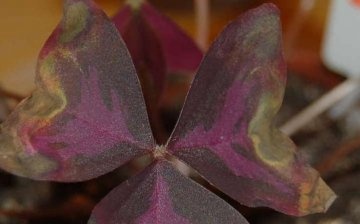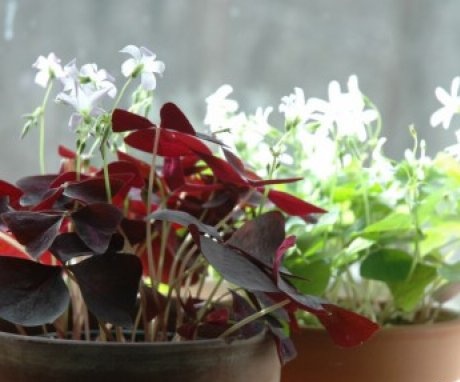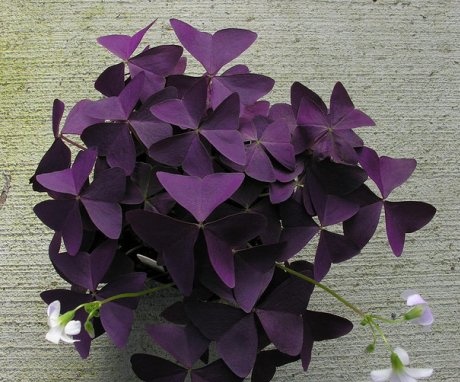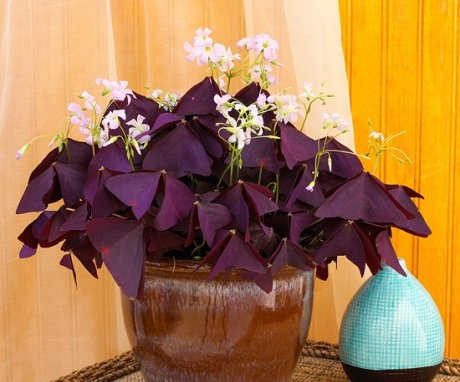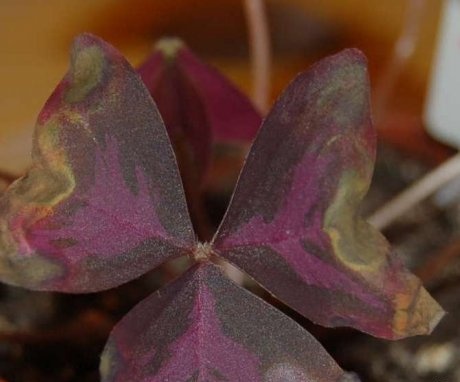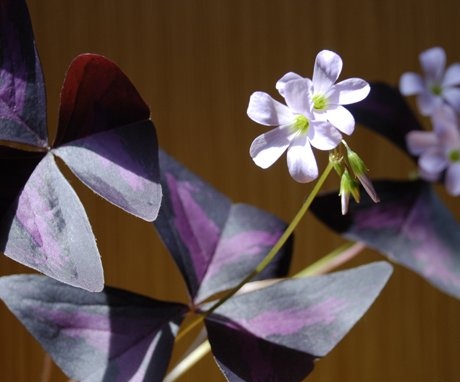Oxalis is a charming and unpretentious indoor flower
Kislitsa (oxalis) is called in different ways: hare cabbage, lucky clover, iron cross, butterfly flower, day and night, or Madame Butterfly. This is a flower from the sorrel family, because its leaves have a sour taste in taste, because they contain oxalic acid in the composition. Oxalis is a rather unpretentious plant, however, some care features must be taken into account.
Content:
- How to recognize acid
- Features of planting and transplanting a plant
- Methods for breeding acid
- Rules for caring for oxalis at home
- Caring for sour during rest
- Plant diseases and pests: treatment and prevention
- Oxalis properties
How to recognize acid
The oxalis flower in nature lives in Central European, South African, South American and Russian deciduous forests. Oxalis is successfully grown in greenhouses and houses. The flower itself is quite miniature, reaching 30 cm in height. The bushes are pubescent with tricuspid or four-leafed leaves, which can fold and wither in the evening, in bright sunlight, in cloudy weather or with mechanical irritation.
The color of the leaves depends on the species and is purple, green or spotted.
Oxalis flowers bloom in late spring or early summer and delight the eye until late autumn and even until the New Year. They can have various colors: lilac, pinkish, yellow, but most often snow-white. Like leaves, oxalis flowers close under certain factors. After flowering fruit-boxes are formed on the plant, which, when ripe, are capable of shooting red seeds.
In winter, oxalis can retire. At the same time, it partially or completely sheds foliage, which quickly grows back with the arrival of spring.
Features of planting and transplanting a plant
For acid, which has a superficial root system, a wide flowerpot is best suited, at the bottom of which drainage must be laid to prevent stagnation of water, which oxalis does not tolerate. A flower extract is prepared by mixing turf, deciduous soil, humus peat and sand in equal proportions. The purchased ready-made potting soil mixture for indoor flowers is also suitable.
The best time for planting and transplanting is spring.
Oxalis tends to grow rapidly, so a young plant must be replanted annually, and sometimes twice a year. An adult plant is transplanted less often - once every 2-3 years, depending on the growth rate.
The acquired acid must be given time to acclimatize in a new place, it takes about a week. Only then can transplant plant. This event should be held in early spring. The transplanting of young plants is carried out by the transshipment method. The roots of an adult flower are shaken off the ground during transplantation and the dead roots are carefully removed. It should be planted in a row of several bulbs. A week after the procedure, the oxalis will thank you with flowering.
Methods for breeding acid
Reproduction of oxalis is carried out in several ways:
- Tubers (daughter bulbs). At the same time, at the end of winter or early spring, several tubers are selected and planted in a common container. Strong deepening is not required, it is enough to sprinkle the planting material with a layer of soil of one centimeter. Until the bulbs take root, the flower is kept at a temperature of 8-11 degrees, periodically moderately moisturizing the soil. After about 30-35 days, the temperature is raised.
- By dividing the roots. This procedure falls on the moment transplants plants. In this case, the root is divided into several parts with a knife or by hand. The separated plants are planted in different containers.
- The seed method, which should also be carried out in the spring. Small the seeds sour liquors are scattered over the soil surface and carefully moisten the substrate by spraying... The size of the seeds makes it possible not to sprinkle them with soil, during irrigation they will hide themselves.
- By cuttings... To do this, carefully separate the stalk with leaves and place it in moistened sand. And kept at a temperature of 23-25 degrees, avoiding direct sunlight. Watering is carried out in moderation. The roots should appear within a month.
Rules for caring for oxalis at home
The oxalis plant is unpretentious, however, for the successful cultivation of an ornamental plant, you will have to follow some rules:
- Location and lighting. Place the plant in a place where you can easily create abundant, but diffused lighting. If it comes into direct sunlight, burns may form on its leaves. The flower can live in the shade, however, in this case, it can lose its decorative effect: the leaves become smaller, and the stems are stretched. In winter and autumn, it is necessary to provide additional lighting by rearranging the plant closer to the window or creating artificial daylight. The best place will be the southwestern and southeastern windowsills, while in the summer, partial shade should be created. Also, oxalis will actively develop in the depths of a bright room, especially if it is placed on a special stand.
- Humidity and temperature. For the proper development of acid, good moisture is needed (40-60%). To do this, in spring and summer, the plant should be regularly spray or place a bowl of water nearby. In the fall, this procedure is gradually stopped in order to prevent flower diseases, but if the air in the room is dry, then spraying continues until winter. The optimal temperature for oxalis is considered to be 21-26 degrees in spring-summer and 11-17 degrees in autumn and winter. Do not place the plant near heating appliances and batteries.
- Irrigation. It is necessary to water the flower sparingly, preventing the soil from drying out. This can ruin the acid. In the period from March to August, the plant needs to be watered often and abundantly, excess water from the sump must be drained. In autumn, the number and frequency of watering is reduced, and in winter, they practically stop. In winter, the soil should be slightly damp. For irrigation, use settled water at room temperature
- Soil and fertilizers. The soil for the plant needs a loose one with an optimally selected composition. After planting, the soil is periodically loosened to provide oxygen access to the roots. Also, the oxalis will respond with gratitude to the introduction of annual dressings, which are usually carried out 1-2 times a month from April to September. Complex fertilizers are suitable for feeding. mineral fertilizers, which are diluted to a concentration half weaker than indicated in the instructions.
Caring for sour during rest
It should be remembered that oxalis can bloom in December, which is why it is called the Christmas flower of happiness and is the best Christmas present for Americans. However, as soon as the last flowers wither, the plant will stop growing and the leaves will wither.This is how the oxalis informs its owners that it needs rest.
When the flower goes to rest, you should not stop caring for it.
During this period, it is recommended to prune the shoots, leaving small stumps (1.5-2 cm) and locate the plant in a cool place, but the temperature should not drop below 10 degrees. It is recommended to reduce watering to a minimum, and to exclude spraying altogether.
In early spring, when oxalis releases young shoots, the plant should be returned to its original place. If necessary, you need to transplant... Oxalis grows quickly and after 30-35 days it will start to shed color.
Plant diseases and pests: treatment and prevention
Although oxalis is rarely affected by diseases and pests, just like any plant, it can get sick. There may be several reasons for such ailments:
- Fungal diseases of the roots. The reasons for this may be excessive irrigation and stagnation of water in the pot, due to lack of or poor quality drainage. Prevention: pre-plant sterilization of soil and containers, reduction of irrigation. Treatment: plant transplant with simultaneous removal of damaged roots.
- Rust. Brown bumps appear on the leaves. To prevent the development and removal of adversity, treatment is carried out fugnicides.
- Spider mite. It manifests itself as spotted leaves and bloom in the form of a sticky cobweb.
- Oxalis is also susceptible to attack by whiteflies and scale insects. To prevent insect attacks, you need to regularly inspect the plant and if the slightest signs of pest activity are found, measures must be taken. To treat insects, wash the flower with soapy water. Then remove all affected areas and carry out processing special fugnicides.
Useful properties of acid sour
For a long time, oxalis has been considered a medicinal plant that can normalize blood pressure, improve metabolic processes in the body, have an anthelmintic effect, remove poisons and toxins, treat scurvy, ulcerative wounds and boils. Oxalis is actively used in folk medicine to strengthen the immune system.
Sour acid is also used in cooking for the preparation of salads. And some types of root vegetables are eaten in pure form. By the time of ripening, the acid in the fruit is replaced by sugar.
However, it should not be forgotten that the plant contains a small concentration of toxic substances, which, if consumed in excess, can lead to the formation of kidney stones.
Kislitsa able to effectively decorate any interior, without requiring special attention. Observing simple rules, you can achieve the active development of the plant.
Many peoples revered the sorrel for the unique property of bringing joy to the house, and the Irish made the image of the sorrel shamrock a national symbol that flaunts on the country's coat of arms.
More information can be found in the video:









